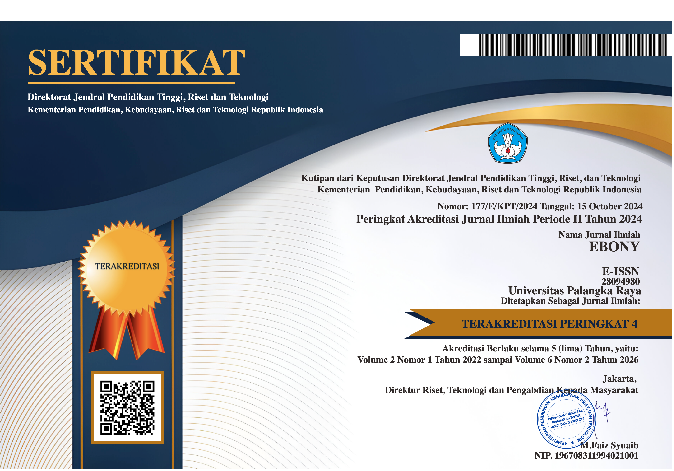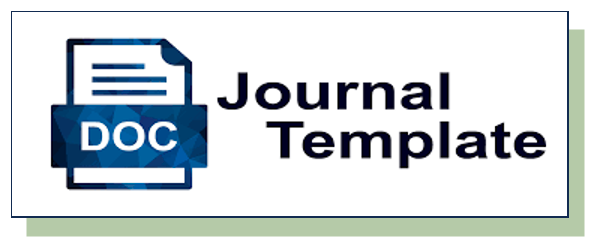Students’ Perception on Flipped Learning Conducted in an Online Writing Class During the Pandemic: A Survey Research
DOI:
https://doi.org/10.37304/ebony.v2i2.5278Keywords:
students’ perception, flipped learning, online writing class, Covid-19 pandemicAbstract
Flipped learning (FL) is the approach used in this research based on two reasons: firstly, the traditional learning fails to facilitate students’ need for knowledge construction, collaboration, and sufficient practice and feedback in online learning; therefore, the teacher had to use another approach called Flipped Learning. Secondly, Flipped Learning has the potency to facilitate the students’ needs mentioned earlier. This research is a survey research and was conducted in an online Writing Class at the university of Palangka Raya and a questionnaire and interview were the instruments used to collect the data needed. The result shows that the success in implementing the FL could be achieved when the four pillars of FL integrated appropriately in the teaching and learning process. As the result, the students gave highly positive responses towards FL that it can facilitate their needs in the online writing class during the pandemic as the four pillars are accordingly implemented; therefore, the pre-learning activities, practices, small group discussions and feedbacks are adequately provided through FL.
Downloads
References
Andujar, A., & Nadif, F. Z. (2020). Evaluating An Inclusive Blended Learning Environment in EFL: A Flipped Approach. Computer Assisted Language Learning, 1–30. https://doi.org/10.1080/09588221.2020.1774613
Arifani, Y., Asari, S., Anwar, K., & Budianto, L. (2020). Individual or Collaborative Whatsapp Learning? A Flipped Classroom Model of EFL Writing Instruction. Teaching English with Technology, 2020(1), 122–139. http://www.tewtjournal.org/
Ary, D., Jacobs, L. C., & Sorensen, C. (2010). Introduction to Research in Education (Eight Edit). Cengage Learning.
Cabi, E. (2018). The Impact of the Flipped Classroom Model on Students’ Academic Achievement. International Review of Research in Open and Distributed Learning, 19(3), 202–221.
Chen Hsieh, J. S., Wu, W.-C. V., & Marek, M. W. (2016). Using The Flipped Classroom to Enhance EFL Learning. Computer Assisted Language Learning, 30(1–2), 1–21. https://doi.org/10.1080/09588221.2015.1111910
Flipped Learning Network Board Members. (2014). The Four Pillars of F-L-I-PTM. http://www.flippedlearning.org/definition
Gürsoy, G., & Orhan Göksün, D. (2020). Flipped learning: As a solution for course duration. Computer Applications in Engineering Education, 29(4), 838–854. https://doi.org/10.1002/cae.22264
Hung, H.-T. (2014). Flipping the classroom for English language learners to foster active learning. Computer Assisted Language Learning, 28(1), 81–96. https://doi.org/10.1080/09588221.2014.967701
Hung, H.-T. (2017). Language Teaching and Technology Forum The Integration of A Student Response System in Flipped Classrooms. Language Learning and Technology, 21(1), 16–27. http://llt.msu.edu/issues/february2017/hung.pdf
Husnawadi. (2021). Students’ Perceptions of Flipped Classroom-Mediated Task: Insights From An Indonesian Post-Earthquake EFL Writing Pedagogy. Teaching English with Technology, 21(1), 8–28. http://www.tewtjournal.org/
Hwang, G., Chang, S., Song, Y., & Hsieh, M. (2021). Powering up flipped learning: An online learning environment with a concept map guided problem posing strategy. Journal of Computer Assisted Learning, 37(2), 429–445. https://doi.org/10.1111/jcal.12499
Jalili, S., Khalaji, H., & Ahmadi, H. (2020). Vocabulary Learning in The Mobile-Assisted Flipped Classroom in An Iranian EFL Context. Teaching English with Technology, 20(4), 82–95. http://www.tewtjournal.org/
Jensen, B. A. (2019). Using Flipped Learning to Facilitate Cross-Cultural Critical Thinking in the L2 Classroom. Die Unterrichtspraxis/Teaching German, 52(1), 50–68. https://doi.org/10.1111/tger.12084
Lee, J., & Choi, H. (2019). Rethinking The Flipped Learning Pre-Class: Its Influence on The Success of Flipped Learning and Related Factors. British Journal of Educational Technology, 50(2), 934–945. https://doi.org/10.1111/bjet.12618
Lee, J., Park, T., & Davis, R. O. (2018). What Affects Learner Engagement in Flipped Learning and What Predicts Its Outcomes? British Journal of Educational Technology. https://doi.org/10.1111/bjet.12717
Noorozi, A., Rezvani, E., & Ameri-Golestan, A. (2021). Students’ Perceptions of The Incorporation of Flipped Learning Into L2 Grammar Lessons. Teaching English with Technology, 21(1), 112–130. http://www.tewtjournal.org/
Swamy Chatta, B., & Imdadul Haque, M. (2020). Improving Paragraph Writing Skills of Saudi EFL University Students Using Flipped Classroom Instruction. Arab World English Journal, 6, 228–247. https://doi.org/10.24093/awej/call6.15
Tsai, Y.-R. (2019). Promotion of Learner Autonomy within The Framework of A Flipped EFL Instructional Model: Perception and Perspectives. Computer Assisted Language Learning, 1–32. https://doi.org/10.1080/09588221.2019.1650779
Wang, Y., & Qi, G. Y. (2018). Mastery-Based Language Learning Outside Class: Learning Support in Flipped Classrooms. Language Learning and Technology, 22(2), 50–74. https://doi.org/https://doi.org/10125/44641
Webb, M., & Doman, E. (2020). Impacts of Flipped Classrooms on Learner Attitudes Towards Technology-Enhanced Language Learning. Computer Assisted Language Learning, 33(3), 240–274. https://doi.org/10.1080/09588221.2018.1557692
Winter, J. W. (2018). Analysis of Knowledge Construction during Group Space Activities in A Flipped Learning Course. Journal of Computer Assisted Learning, 34(6), 720–730. https://doi.org/10.1111/jcal.12279
Wu, W.-C. V., Yang, J. C., Scott Chen Hsieh, J., & Yamamoto, T. (2020). Free From Demotivation in EFL Writing: The Use of Online Flipped Writing Instruction. Computer Assisted Language Learning, 33(4), 353–387. https://doi.org/10.1080/09588221.2019.1567556
Zainuddin, Z., & Halili, S. H. (2016). Flipped Classroom Research and Trends from Different Fields of Study. The International Review of Research in Open and Distributed Learning, 17(3), 313–340. https://doi.org/10.19173/irrodl.v17i3.2274
Downloads
Published
How to Cite
Issue
Section
License
Copyright (c) 2022 Yulitriana, Olga Dona Retsi, Eriani, Indrini Oktamelinae, Yogi Atma Pratama

This work is licensed under a Creative Commons Attribution-NonCommercial 4.0 International License.











